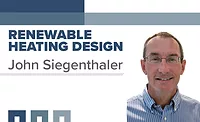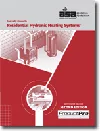Some ways to simplify hydronic systems
Less is best when it comes to hydronic heating systems.
After completing a hydronic installation, especially one that’s taken you a few days longer than expected, do you ever ponder that there is just too much “stuff” in some of these systems? Sometimes it’s amazing how a well-organized two-dimensional schematic, one that looks so well-thought-out on paper, can morph into a complex and confusing 3D hardware assembly.
Many of us have seen prize-winning hydronic systems displayed in trade journals and other publications over the years. Most of those systems are one-of-a-kind works of art. With proper design, documentation and scheduled maintenance, they can serve their owners well. However, take away any of these requisites and you have a very expensive collection of hardware that nobody seems to understand or wants to service.
The latter scenario is a serious issue for our industry, especially for those who insist upon “reinventing the wheel” with each new system. The last thing the North American hydronics industry needs is for consumers to think that systems have to be complex and expensive to serve their intended purpose.
Let’s take a look at ways of simplifying hydronic heating systems. The goal is to trim away at design details and hardware that, in many cases, don’t need to be there for the system to deliver efficient operation and superior comfort.
Independent supply temps
Radiant floor-heating systems with multiple supply water temperatures are often “prescribed” by design procedures and related software. An example is a system that heats a bare concrete slab in the basement and wood-framed floors above. The latter could be heated by a gypsum thin-slab, tube-and-plate staple-up or a manufactured panel system.
A common approach is to set up a separate mixing device for each type of radiant panel construction. Some designers specify a separate mixing assembly for areas with different types of floor coverings. Sometimes a separate mixing assembly also is specified on a floor-level basis, even when the water temperature requirements of the panels serving those floor areas are the same.
I’ve designed residential systems with three different mixing assemblies and I’ve seen systems having at least five independent mixing assemblies. Do these systems work? Sure they do. Is their complexity justified? Not necessarily.
Here’s some criteria to help you decide if multiple water temperatures are needed:
- Add up all the circuit supply water temperatures calculated for design load conditions.
- Calculate the average of these supply temperatures.
- If the supply temperature for a given circuit is more than 10° F above or below the average supply water temperature, identify it.
- Consider modifying any of these identified circuits through changes in tube spacing to increase or decrease their required supply water temperature at design load conditions. Try to bring the temperature within +/- 10° of the average temperature of all circuits. Remember to calculate a new average temperature each time a circuit supply water temperature changes.
For basements, consider tube spacings of up to 18 in. or even 24 in. if the basement is infrequently used and floor surface temperature variations are not deemed a significant problem.
Here’s an example: Suppose you’re planning tubing for a bare concrete slab and need 20 Btu/hr./ft.2 of heat output at design load conditions. The space is to be maintained at 70° under these conditions. Using Figure 1 as a reference, at 12-in. tube spacing, the average circuit water temperature needs to be about 27° above the room air temperature (e.g., 27 + 70 = 97°).
However, the same building also has a gypsum thin-slab for the upper floor and at design load those circuits need 115° average water temperature. Increasing the tube spacing in the concrete slab portion of the system to 18 in. increases the average water temperature to about 104°. Assuming a nominal 20° circuit temperature drop, the supply temperatures for these circuits would be about 97 + 20/2 = 107° and 104 + 20/2 = 114°, respectively.
These supply temperatures are within 10° of each other and could very likely be supplied from the same system. In this case, the controls could be set to produce a supply temperature midway between these two values (around 110°).
In this situation, one might argue that it’s better to decrease the tube spacing on the higher-temperature circuits and thus bring the average system water temperature down to promote efficiency gains at the heat source. This is a valid point for systems using mod/con boilers, geothermal heat pumps or solar collectors as heat sources. Only a life-cycle cost comparison that factors in the changes in heat source efficiency vs. the higher installation cost of more tubing can provide a substantiated answer.
When a conventional (noncondensing) boiler is used, the changes in boiler efficiency are likely to be minimal and the cost savings will be largely derived by not installing multiple mixing assemblies.
5. If variations in tube spacing aren’t enough, discuss the possibility of different finish flooring with the client before giving up on the use of a single supply temperature.
I’ve found it possible to combine slab-on-grade systems with both thin-slabs and even underfloor tube-and-plate systems in certain circumstances. Eliminating the need for multiple mixing assemblies in these situations can reduce installation costs by hundreds of dollars.
When a single supply water temperature is possible, consider zoning manifolds using zone valves or individual circuits using manifold valve actuators. Another possibility is to mix in “wireless” thermostatic radiator valves for zone control. This approach sets the stage for a simple delivery system using a single variable-speed, pressure-regulated circulator. An example of such a system is shown in Figure 2 (page 21).
When two simultaneous supply water temperatures are required, consider using proportional reset control with a manually set “dumb” mixing valve. An example is shown in Figure 3 (page 24).
The dumb mixing valve does not have a thermostatic or motorized actuator. It simply maintains a set mixing ratio between the entering hot and cool streams. When the temperature of the hot stream varies based on outdoor reset, the outlet temperature from the valve also varies along a shallower reset line as shown in the graphs below the schematic.
Keep in mind that proportional reset is not well-suited for spaces that must recover quickly from setback conditions or will be subject to frequent changes in thermostat settings or internal heat gains. The reason is the dumb mixing device cannot respond to such changes as quickly as can a “smart” mixing device that senses and responds to changing water temperatures. If the space served by the low-temperature system doesn’t meet these constraints, it’s better to use a motorized mixing valve.
Fewer zones
The ability to divide a heating system into several independently controlled zones is a preeminent benefit of hydronics. Several techniques can be used to provide multiple zones in almost any modern hydronic system.
However, just because you can set up every room in a building as a separate heating zone doesn’t mean you should. This is especially true when installing wired zone controls. By the time all the transformers, valve actuators, relay centers and thermostats are connected, you may have installed a couple miles of cable.
It’s tedious work that can easily add $2,000 to $3,000 to installed cost. Even when money isn’t an issue, all those thermostats may end up being used to balance heat flow within the building, rather than for continuous readjustment of interior space temperature.
In keeping with the theme of simplification, it’s important to not “over-zone.” When selecting zones, look for open areas in the building. Such areas tend to find equilibrium temperatures and seldom need to be on separate zones. Also look for areas that receive significant solar heat gain and put them on separate zones from nonsolar gain areas.
If you really like the idea of room-by-room zone control, consider using wireless thermostatic radiator valves. They’re available for use in baseboard and panel radiator systems as well as in wall-mounted boxes for site-built radiant panel systems. No wires and fully modulating control. Some manufacturers even offer battery-powered automatic setback actuators if needed.
Less transformers, adapter fittings
Ever been in a mechanical room with several transformers mounted on 4x4 J-boxes, buzzing away 24/7? If you put your hand on them they will feel warm. That’s because they’re converting electricity into heat through their primary winding, regardless of whether an active load is available on their secondary winding.
The installed cost of multiple transformers is certainly more than the transformers themselves. Each needs a J-box and associated wiring. Consider control arrangements that turn off transformers when portions of the system they serve are not needed (i.e., why let the transformer(s) in a cooling system operate during the heating season and vice versa).
I used to think a box full of fittings and shut-off valves as incidental to the overall hardware cost for a hydronic system. That’s changed considerably as the prices of copper and brass have soared. Even back in 2006, the estimated installed cost of a 3/4–in. MxC copper adapter fitting in the RS Means Mechanical Cost Data book, including overhead and profit, was $32 each. That added $64 to the cost of installing an F x F 3/4-in. ball valve such as shown in Figure 4.
My advice is to get away from installing threaded adapter fittings whenever possible. Go with soldered or press-fittings instead. This could trim a box full of copper fittings out of your next system.
Less antifreeze
I have a philosophical statement about antifreeze — “The only good thing about antifreeze is that it doesn’t freeze.” Think about it. Glycol-based antifreeze decreases the heat capacity of the fluid relative to water. This requires an increased flow rate, relative to water, to achieved the same rate of heat transfer.
The higher viscosity of glycol-based antifreeze also adds significantly to head loss. At 120º, a 50% solution of propylene glycol increases head loss (at the same flow rate) by about 24%. When the flow rate is increased to compensate for the reduced heat capacitance of this antifreeze solution, the head loss goes up by 47%! That translates to more circulator input power and higher operating cost. Finally, filling a system with a 50% glycol solution can add a few hundred bucks to installed cost.
So where should antifreeze be used? Well, snow-melting systems and closed-loop solar collectors obviously need the protection it offers. In Northern climates, we also specify glycol in residential garage heating circuits and in homes that will be unoccupied for several consecutive winter days.
We used to specify antifreeze for floor-heating systems in large slab-on-grade facilities such as highway garages. However, many of these buildings now have emergency generators that can keep circulators and even the boiler running during a prolonged power outage. With constant circulation, the heat stored within a concrete slab gets “stirred” throughout the slab.
This can protect the embedded tubing circuits from freezing for several cold winter days, even if the boiler is not operating. Given these favorable odds, we now avoid specifying antifreeze in this type of facility.
It’s always a bit precarious to write about removing hardware from systems. That hardware produces income for its manufacturer right down to the professional who installs it. It’s nothing personal that prompts me to write about reducing or eliminating certain hardware.
Instead, it’s about keeping the cost and complexity of modern hydronic systems competitive with the many alternatives now vying for consumer dollars. That goal requires periodic self-examination of what we do as professionals. We want to increase market share, not parts count. Why build the space shuttle when our clients need a Cessna?
HELPFUL LINKS:
Looking for a reprint of this article?
From high-res PDFs to custom plaques, order your copy today!








